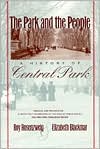

 |

|

The average rating for The Park and the People : A History of Central Park based on 2 reviews is 4 stars.
Review # 1 was written on 2016-01-13 00:00:00 James Atkins James AtkinsThe meaning of public space is the topic of Roy Rosenzweig and Elizabeth Blackmar's The Park and the People: A History of Central Park, which follows New York's most famous green space from initial conception to its contemporary use. Combining urban, political and design history with a New Social history lens, the authors give an overview of the park as both a physical space and abstract embodiment of public ideals, resulting in both the familiar narrative of American ingenuity as well as a revisionist account of one of America's most famous parks. Rosenzweig and Blackmar structure their findings chronologically, beginning with the political and socioeconomic makeup of nineteenth century Manhattan and the multiple expectations and interpretations of the park, most of which fell along class lines. The elites who conceptualized and built the park wanted three things: a park to compete with those of Europe, a place to see and be seen by other elites, and a place of "naturalness" to pacify the immigrant and working classes. The latter groups wanted a democratic and egalitarian space for unrestricted assembly and recreation. The authors argue that despite its supposedly public status, the park became and remains a space reserved for middle and upper classes. Their argument, that although Central Park was created with the promise of being a public space it was destined to be a place of class division, is coherent and convincing. The authors give multiple examples of immigrant and working classes being excluded from public life, but the argument would have been sufficiently made without the seemingly endless policy and real estate data that overwhelms the first half of the book. Despite the often unnecessary attention to detail, the authors demonstrate the highly discriminative nature of a supposedly public space and how these problems are still present today. |
Review # 2 was written on 2015-12-01 00:00:00 Debbie Tkachyk Debbie TkachykThis history of NYC's iconic public park reframes its history as one of a battle for space by classes. From its very founding, which cleared out black and irish communities to make room for a place for the city's elites to compete with European elites in beauty, as well as push for a social setting for elites to mingle and the idea that all residents of the city would benefit by access to seeing a natural environment. The poor immigrant and black residents of the city were systematically excluded from both participation in the park, through informal policies such as carriage access and formal running of the park by the better classes, to explitly banning of large public gatherings or popular recreational activity such as picnics or sports by the poor. It builds upon Rosensweig's work around how struggles for access to recreation is just as important as workplace struggles, and how space is harnessed for elites if not unchallenged. |
CAN'T FIND WHAT YOU'RE LOOKING FOR? CLICK HERE!!!